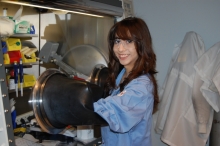
Major:
Mentor(s):
Faculty Sponsor(s):
Faculty Sponsor's Department(s):
Project Title:
Project Description:
Organic Photovoltaics (OPVs) are potentially cost effective alternatives to inorganic solar cells. However, OPV devices require further study to understand the system and materials in order to increase power conversion efficiency. We investigated an alternative to polydimethylsiloxane (PDMS) soft contact lamination using thiolene based stamps to make contact between the device and the metal electrode. Unlike PDMS stamps, thiolene stamps do not need to be surface treated prior to metal deposition, creating a faster and facile process for using stamps. Thiolene stamps were prepared from triallyl cyanurate (TAC), diacrylate of ethoxylated bisphenol A (BPADMA), and the polymer poly[(mercaptopropyl)methylsiloxane] (PMMS), which were mixed with initiator 2,2-dimethoxy-2-phenylacetophenone (DMPA) and exposed to UV to initiate cross-linking and cure the stamp. The physical properties of the stamp can be controlled by the polymer ratios and stamp thickness. For instance, the mixture can be engineered to prevent the stamp from peeling the polymer layer off of the device when the stamp (and contacts) are removed. The OPVs used in this study consisted of a glass substrate coated with a conductive oxide, a thin polymer layer and a bulk heterojunction (P3HT/PCBM) active layer. The metal electrode (gold or aluminum) was evaporated onto the thiolene stamp and placed over the device. Thiolene stamps wet the polymer active layer well creating good electrical contact but also allowing stamps to be removed for further study of the interface of the polymer layer and metal contact.
